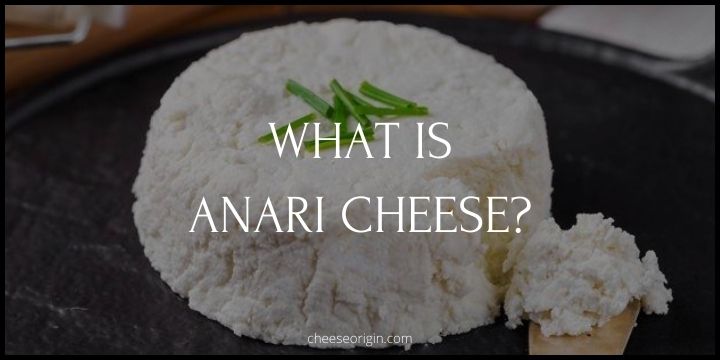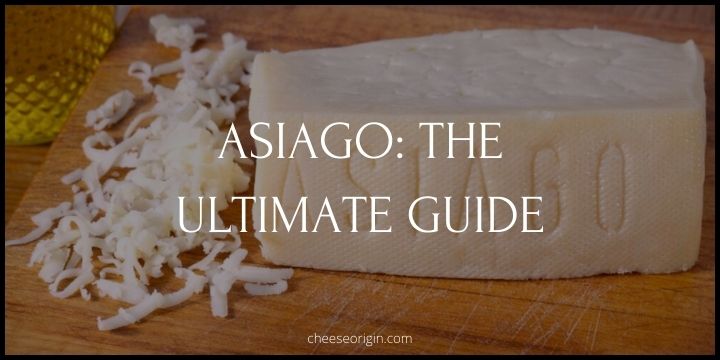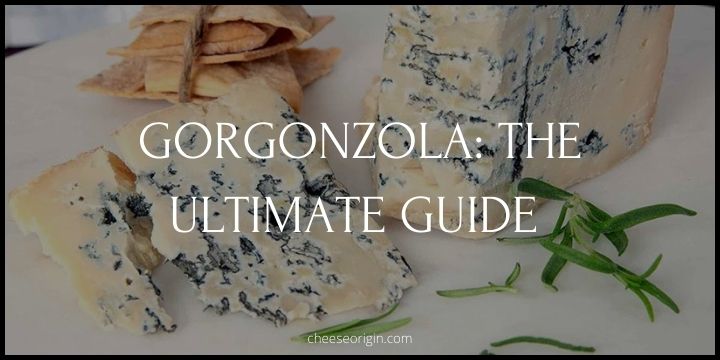What is Halloumi? Your Ultimate Cheese Guide
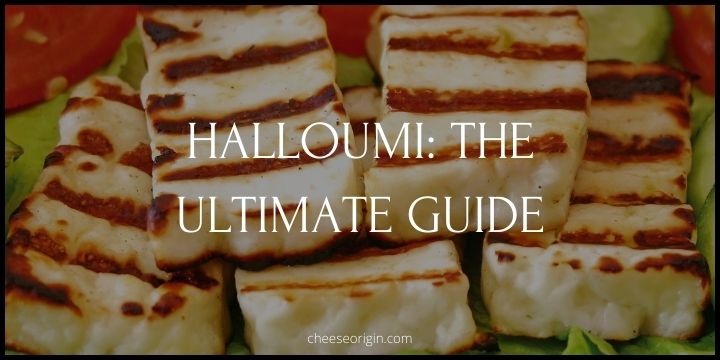
Halloumi, a unique, semi-hard cheese hailing from the beautiful island of Cyprus, is making a name for itself around the globe. With its high melting point and robust flavor, it’s the perfect addition to your grill and a star on any dining table.
Whether you’re familiar with this Mediterranean delight or hearing about it for the first time, our in-depth guide is here to take you on a culinary journey.
We’ll explore the rich history of Halloumi, its distinct characteristics, and how you can incorporate it into your next barbecue for a gourmet twist. So, fire up your grills and prepare your palate for an unforgettable cheesy adventure!
Quick facts about Halloumi
| Fact Category | Details |
|---|---|
| Origin | Cyprus |
| Region | Nicosia, Limassol, Larnaca, Famagusta, Pahpos, Keryneia |
| AOP / PDO | Since 2015 |
| Type | Semi-hard, unripened, brined cheese |
| Made from | Goat’s and Sheep’s milk (sometimes Cow’s milk) |
| Taste | Slightly salty, tangy, and has a hint of mint |
| Texture | Firm and springy with a unique “squeaky” quality when bitten into |
| Cooking | High melting point allows it to be easily fried or grilled |
| Serving Suggestions | Grilled as an appetizer, sliced in salads, used in cooking, or eaten fresh |
| Nutrition | High in protein and calcium, but also high in fat and salt |
| Shelf Life | Can last up to a year if kept in its brine |
| Availability | Year-round, available in most supermarkets and specialty cheese stores |
What is Halloumi?
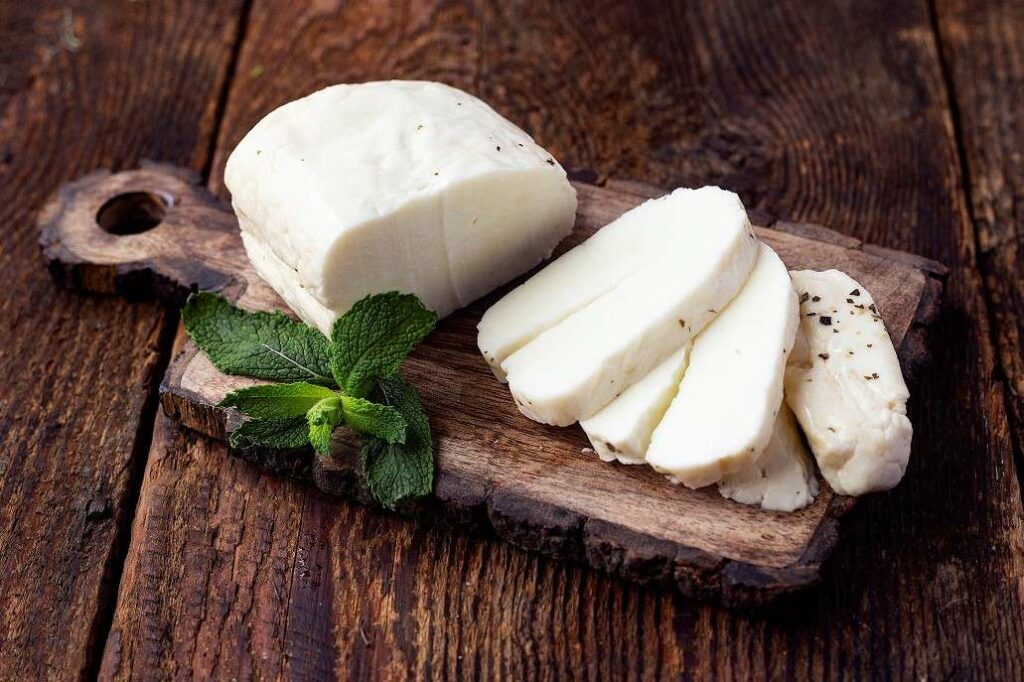
Halloumi is a type of semi-hard, unripened, brined cheese that originates from the island of Cyprus in the Eastern Mediterranean. It’s traditionally made from a mixture of goat’s and sheep’s milk, although some versions also include cow’s milk.
What sets halloumi apart from many other types of cheese is its high melting point, which allows it to retain its shape when cooked. This makes it an excellent choice for grilling or frying. Halloumi is known for its layer of mint in the middle, which gives it a distinctive, refreshing flavor.
The texture of halloumi is quite unique as well. It’s firm and slightly springy, and it has a characteristic “squeak” when you bite into it. The taste of halloumi is usually described as being salty, tangy, and slightly creamy.
It’s a versatile cheese that can be used in a variety of dishes, from salads and sandwiches to skewers and side dishes. Whether served fresh, grilled, or pan-fried, halloumi adds a delicious and unique touch to any meal.
What does Halloumi taste like
Halloumi cheese is a delightful blend of savory and slightly tangy flavors. Its taste is often described as salty, due to the brine it’s kept in, with a hint of tanginess that can be likened to that of yogurt or mildly fermented cheese.
What makes halloumi truly unique, however, is its hint of mint. Traditionally, a layer of mint leaves is placed in the middle of the cheese, infusing it with a subtle, refreshing flavor. This minty undertone helps balance out the saltiness and adds a distinctive touch to the cheese.
The texture of halloumi also contributes to its overall taste experience. It’s semi-hard and maintains its shape when cooked, providing a satisfying chew. When grilled or fried, halloumi develops a beautiful golden crust while remaining soft and slightly creamy on the inside, adding a delightful contrast of textures to its rich flavor profile.
Note: the specific taste of halloumi can vary slightly depending on the types of milk used in its production and the exact preparation methods.
Halloumi tasting notes
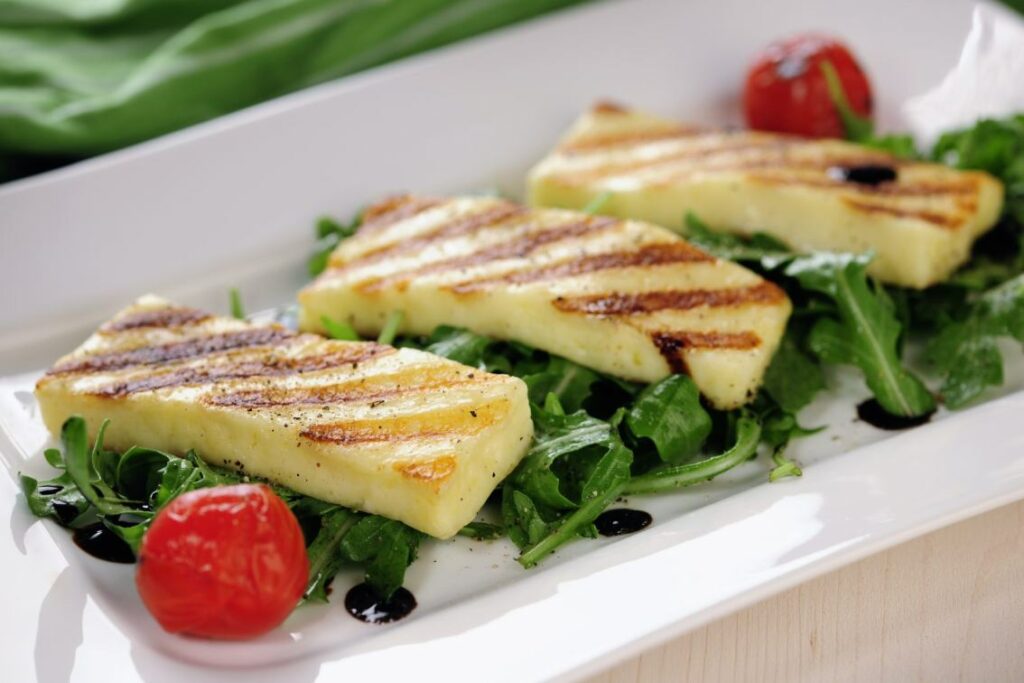
- Appearance: Halloumi is a semi-hard cheese that usually comes in a rectangular or square shape. It has a smooth, shiny exterior with a white to light yellow color.
- Texture: The texture of halloumi is unique and quite distinctive. It’s firm yet slightly springy or rubbery to the touch. When cooked, it maintains its shape and develops a crispy outer layer while staying creamy and soft on the inside.
- Aroma: Halloumi has a mild, milky aroma. When grilled or fried, it releases a tantalizing, buttery scent that’s hard to resist.
- Taste: The taste of halloumi is predominantly salty due to the brine it’s stored in. This saltiness is balanced by a slight tanginess, similar to that of yogurt or mildly fermented cheese. There’s also a subtle hint of mint, which adds a refreshing note to the overall flavor profile.
- Aftertaste: The aftertaste of halloumi is generally clean and slightly salty, with mild tanginess and minty undertones lingering on the palate.
- Pairings: Halloumi pairs well with a variety of foods and flavors. It’s excellent in salads, particularly those with fresh fruits like watermelon or figs. It also goes well with grilled vegetables, bread, and robust sauces. In terms of beverages, it pairs nicely with crisp white wines, light beers, or even a refreshing cider.
Is Halloumi a healthy cheese?
Halloumi cheese, like many foods, can be both healthy and unhealthy depending on the context of its consumption.
Here are some key points to consider:
- Nutrient-Rich: Halloumi is rich in calcium, which is crucial for muscle and nerve function, as well as for maintaining strong bones and teeth. It’s also a good source of dietary magnesium and phosphorous, nutrients that, along with vitamin D, aid in bone health.
- High in Saturated Fat: On the downside, halloumi is high in saturated fat (12g per 70g), which has been linked with ‘bad’ cholesterol levels. Therefore, it should be consumed in moderation.
- Calorie Content: Halloumi is relatively high in calories. This isn’t necessarily a bad thing, but it’s something to keep in mind if you’re watching your calorie intake.
- Salt Content: Halloumi is often stored in brine, which makes it quite high in sodium. This could pose a concern for individuals monitoring their salt intake due to conditions like hypertension.
- Weight Gain: As for concerns about weight gain, halloumi is not considered particularly fattening. Cheese contains protein and healthy fats, and while it does have a higher salt content, this does not directly contribute to weight gain.
Halloumi nutrition facts
| Nutrient | Amount (per 28g serving) |
|---|---|
| Calories | 85 – 110 |
| Carbohydrates | 0 – 1g |
| Protein | 7g |
| Fat | 6.3 – 9g |
| Saturated Fat | 5.1g |
| Cholesterol | 19.9mg |
| Sodium | 350mg |
| Calcium | 25% of the Daily Value |
| Magnesium | Not specified |
| Phosphorous | Not specified |
| Fiber | 0g |
| Sugars | 0 – 1g |
How to Cook Halloumi Like a Pro: An In-depth Guide
Halloumi cheese is traditionally made from a mixture of goat’s and sheep’s milk, although some varieties also include cow’s milk. It has a layered texture similar to mozzarella but is far denser, giving it a satisfying “squeaky” feel when bitten into. Its taste is distinctive – tangy, salty, and slightly creamy. When cooked, it develops a beautiful golden crust that adds an extra layer of flavor and texture.
How to Prepare and Cook Halloumi
Preparation:
- Drain: Remove the halloumi from its brine and pat dry.
- Slice: Cut the halloumi into 1/2 inch thick slices.
Cooking Techniques:
- Grilling: Preheat your grill to medium-high heat. Grill each side of the halloumi slices for 2-3 minutes, until they’re marked and golden.
- Frying: Heat a non-stick pan over medium-high heat. Add the halloumi slices and cook for 2-3 minutes per side, until golden brown.
- Baking: Preheat your oven to 375°F (190°C). Place the halloumi slices on a baking sheet lined with parchment paper and bake for 10-15 minutes, until golden and crispy.
Seasoning and Serving
While halloumi is flavorful on its own, you can also season it with herbs like oregano, mint, or rosemary before cooking. After cooking, a squeeze of lemon juice can help cut through the saltiness.
Halloumi is best served immediately while it’s still warm and has a soft, creamy interior contrasted by its crispy exterior. It can be served on its own, in a salad, sandwich, or even skewered with vegetables on the grill. The cheese pairs wonderfully with sweet elements like honey, figs, or watermelon to balance out its saltiness.
Pairing Suggestions
- Vegetables: grilled zucchini, bell peppers, cherry tomatoes.
- Fruits: fresh peaches, pears, or a tangy citrus salsa.
- Meats: lamb, chicken, or included in a mixed grill.
- Scroll below for more pairing suggestions
Fun Facts About Halloumi
Did you know that halloumi is one of the few cheeses that doesn’t melt when heated? This is due to its higher-than-normal melting point, which allows it to retain its shape under heat.
Mastering halloumi is a great way to add a versatile and delicious ingredient to your culinary repertoire. With its unique texture and flavor, it’s sure to impress at your next dinner party or family meal. Happy cooking!
The pros and cons of Halloumi
Advantages:
- Rich in Nutrients: Halloumi is a good source of protein and provides calcium, which is vital for bone health. It also contains small amounts of Vitamin A, Vitamin B, magnesium, and zinc.
- Versatility in Cooking: Halloumi has a high melting point, which makes it great for grilling or frying. It retains its shape when cooked, unlike many other types of cheese.
- Unique Flavor & Texture: Halloumi has a distinctive, slightly salty flavor and a firm, elastic texture that’s appreciated by many.
- Suitable for Vegetarians: Most brands of halloumi are made without animal rennet, making it suitable for vegetarians.
Disadvantages:
- High in Sodium: Due to the brine it’s stored in, halloumi can be quite high in sodium. This could pose a concern for individuals monitoring their salt intake due to conditions like hypertension.
- Calorie-Dense: Halloumi is relatively high in calories. This isn’t necessarily a bad thing, but it’s something to keep in mind if you’re watching your calorie intake.
- High Saturated Fat Content: Halloumi is high in saturated fats, which, if consumed in excess, can contribute to high cholesterol levels and heart disease.
- Not Suitable for Vegans: As a dairy product, halloumi is not suitable for vegans.
- Allergen Potential: As with all dairy products, halloumi contains lactose, which can cause digestive problems for individuals with lactose intolerance.
Also read: Savor the Flavor: 20 Cheeses with the Least Lactose
What is the best way to eat halloumi cheese?
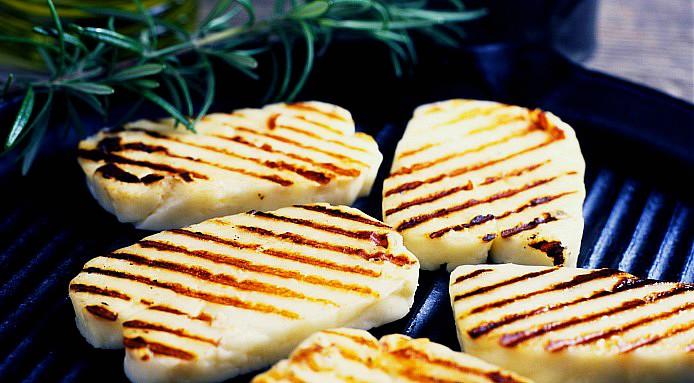
Halloumi cheese is incredibly versatile and can be enjoyed in a variety of ways. Here are some popular methods:
- Grilled or Fried: Halloumi cheese is known for its high melting point, which makes it perfect for grilling or frying. You can slice the cheese and cook it on a grill or in a nonstick pan until it’s golden brown on both sides. The result is a crispy outside with a warm and soft inside.
- In a Salad: Grilled or raw halloumi can be added to salads for an extra punch of flavor and texture. It pairs well with fresh fruits like watermelon or figs, as well as with vegetables like tomatoes and cucumber.
- Sandwiches or Wraps: Slices of grilled halloumi make a tasty addition to sandwiches or wraps. Combine with fresh veggies, a bit of hummus or a drizzle of pesto for a delicious meal.
- Kebabs: Cube the halloumi and thread it onto skewers with vegetables like bell peppers, cherry tomatoes, and zucchini. Grill until the cheese is golden and the vegetables are tender.
- Pizza Topping: Halloumi can be used as a unique and flavorful pizza topping. Just add slices or cubes of the cheese to your pizza before baking.
- Stirred into Pasta: Cubed halloumi can be tossed into hot pasta dishes just before serving. It adds a nice contrast of texture and a burst of salty flavor.
- Baked: Baking halloumi with a drizzle of olive oil and a sprinkle of herbs creates a delicious appetizer that can be spread on crusty bread.
Also read: What is the Best Cheese for Pizza?
7 best Halloumi substitutes
| Substitute | Explanation |
|---|---|
| Feta | Feta cheese is a popular substitute because it has a similar texture to halloumi and can also be grilled or fried. However, feta has a creamier texture and a tangier flavor. |
| Paneer | Paneer, also known as Indian cottage cheese, is another firm, white cheese that doesn’t melt easily, making it a good option for grilling or frying just like halloumi. |
| Queso Para Frier | This is a type of cheese specifically designed for frying, so it holds up well under heat, much like halloumi. It’s a popular choice in Latin cuisine. |
| Queso Panela | Queso Panela is a Mexican cheese that retains its shape when heated and has a mild flavor, similar to halloumi. |
| Kefalotyri | This is a hard, salty Greek cheese made from sheep or goat’s milk. It’s another cheese that holds up well to heat, and its salty flavor makes it a good stand-in for halloumi. |
| Saganaki | Named after the pan in which it’s traditionally fried, Saganaki is a Greek cheese that’s often served flambéed. It’s rich and salty, with a texture that stands up to cooking. |
| Anari | Anari is a fresh mild whey cheese produced in Cyprus. Although less salty than halloumi, it has a similar texture and taste. |
Is Halloumi like Mozzarella?
Halloumi and Mozzarella are both types of cheese, but they have distinct characteristics that set them apart:
| Aspect | Halloumi | Mozzarella |
|---|---|---|
| Texture | Halloumi has a firm and rubbery texture. It holds its shape well when cooked due to its high melting point. | Mozzarella has a soft and moist texture. It melts easily, making it ideal for pizzas and pasta. |
| Flavor | Halloumi has a strong, salty flavor, as it is often stored in brine. | Mozzarella has a mild, milky flavor. |
| Production Process | Traditionally made from a mixture of goat’s and sheep’s milk (or sometimes cow’s milk). It is often garnished with mint. | Typically made from buffalo’s milk (Mozzarella di Bufala) or cow’s milk. It is not flavored with any additional herbs. |
| Origin | Halloumi originates from Cyprus. | Mozzarella originates from Italy. |
| Use in Cooking | Due to its high melting point, halloumi is often grilled or fried. It’s popular in salads, sandwiches, and Mediterranean dishes. | Mozzarella is commonly used in Italian cuisine, particularly on pizzas, in pasta dishes, and in Caprese salads. It’s appreciated for its ability to melt and stretch. |
While both are enjoyed worldwide and have their unique uses in cooking, they’re quite different in terms of taste, texture, and preparation.
>> Click here to read our in-depth guide on Mozzarella
What pairs well with Halloumi
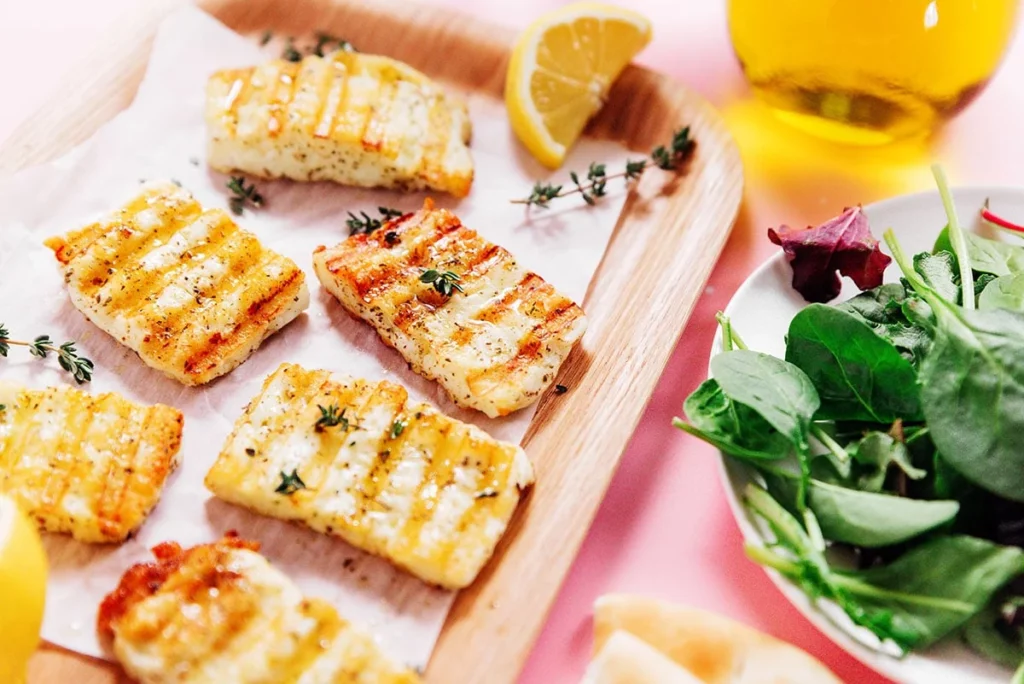
Food that goes well with Halloumi
| Category | Foods That Pair Well With Halloumi |
|---|---|
| Bread | Garlic Bread |
| Vegetables | Red Peppers, Aubergine, Sweet Potato, Spinach, Mixed Vegetable Salad |
| Fruits | Nectarine, pears |
| Grains | Couscous, Crispy Rice Cakes |
| Proteins | Sausage, lamb, chicken |
| Spices/Herbs | Harissa, Mint, Za’atar |
| Dairy | Yoghurt (chilli yoghurt) |
| Others | Hummus, Beetroot |
Beverage that goes well with Halloumi
| Category | Beverages That Pair Well With Halloumi |
|---|---|
| White Wine | Sparkling White Champagne, White Chablis, White Chablis Grand cru, White Chablis Premier cru, White Wine of Burgundy, Oaked Chardonnay, Assyrtiko (indigenous grape of Santorini in Greece) |
| Red Wine | Primitivo, Zinfandel, Merlot, Cabernet Sauvignon, Pinot Noir |
| Rosé Wine | Provence Rosé |
| Others | Lemon Juice (as part of a Honey Glazed Halloumi recipe) |
Also read: Best Wine and Cheese Pairings: The Ultimate Guide
The History and Origin of Halloumi
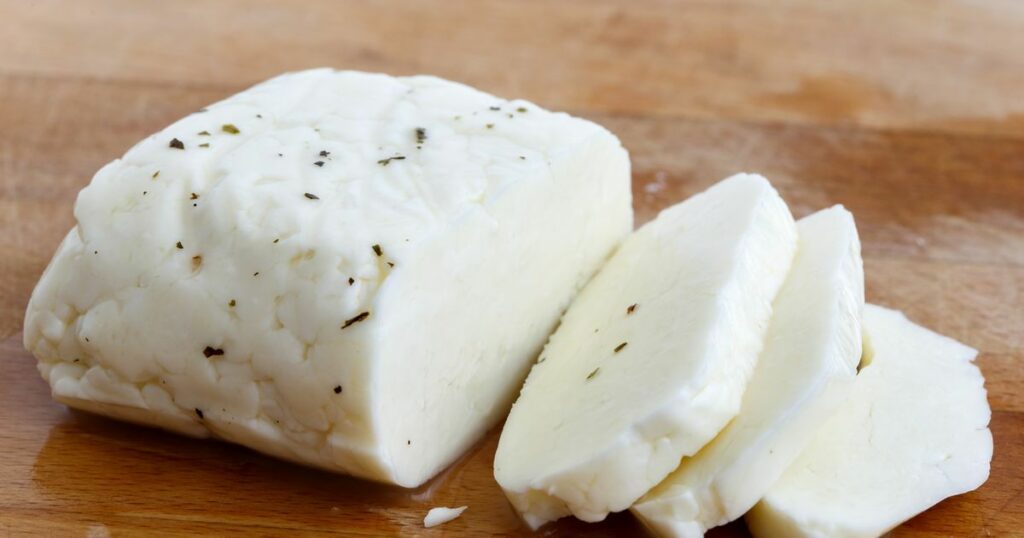
Halloumi, also known as haloumi, is a cheese that originates from the Eastern Mediterranean. It is traditionally made from a mixture of goat’s and sheep’s milk, and sometimes also cow’s milk. The cheese has a long history, with its production in Cyprus dating back to ancient times. The first documented reference to halloumi was written in 1556 by Doge Leonardo Donna.
Originating from Cyprus, halloumi is a traditional Cypriot semi-hard, pasteurized cheese. Halloumi/Hellim cheese symbolizes the shared heritage of the island of Cyprus, linking the communities living there. It is a semi-hard cheese made principally in Cyprus from sheep or goat milk or a mixture of the two.
Halloumi-style cheese was originally made by Bedouins in the Middle East, as its good-keeping qualities made it ideal for their nomadic lifestyle. The cheese originated in Cyprus and was initially made during the Medieval Byzantine period, subsequently gaining popularity throughout the rest of the Middle East.
According to Bevan, the most famous cheese that was most often produced in Cyprus at the beginning of the 19th century was “Halloumi”. Halloumi is believed to have originated from the Middle East as a Bedouin cheese made from ewes’ milk.
In summary, Halloumi has a rich history and origin rooted in the Eastern Mediterranean, specifically Cyprus, and has been a significant part of the region’s culinary tradition for centuries.
Frequently Asked Questions
1. Can you eat Halloumi without frying?
Yes, you can eat Halloumi without frying it. While most people are accustomed to eating halloumi after it’s been cooked—usually fried or grilled—halloumi can also be eaten raw. Cooking does enhance the taste and texture of halloumi, giving it a crispy exterior and a soft, melty interior.
However, if you prefer, you can certainly enjoy it uncooked. It’s worth noting that halloumi has a high melting point, which makes it an excellent choice for grilling or frying.
2. Should you wash Halloumi before cooking?
You do not have to wash halloumi before cooking it. You just need to drain the cheese from the brine in its packaging. However, if you notice a foul smell or mold on the cheese, it should not be consumed.
Some people choose to soak halloumi in water before cooking to reduce its saltiness, but this is a matter of personal preference and not a requirement. It is important to pat the cheese dry after soaking to ensure it gets a nice golden color when cooked.
3. How do you pronounce Halloumi?
Halloumi is pronounced as “ha-LOO-mee”. The emphasis is on the second syllable.
Also read:
- Menonita Cheese: A Staple in Northern Mexican Cuisine
- All About Roquefort: An Insider’s Guide to the King of Blue Cheese
- Asiago Cheese: An In-depth Exploration of Nutrition and Taste
- The Ultimate Guide to Muenster Cheese: Savor the Flavor
- Ricotta Guide: All You Need to Know About This Versatile Cheese
- Emmental: A Comprehensive Guide to Switzerland’s Cheese Haven
- The Ultimate Guide to Kasseri: A Taste of Tradition
